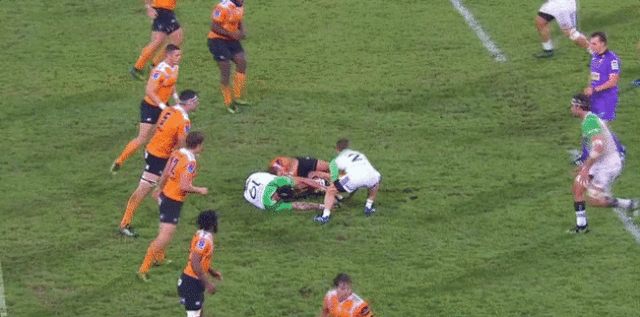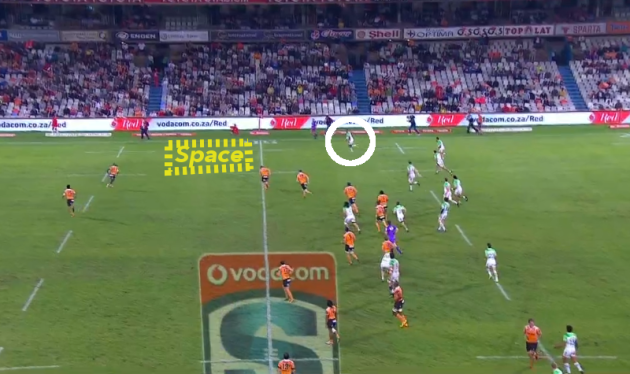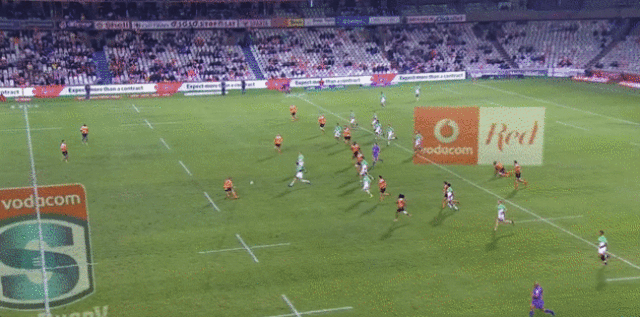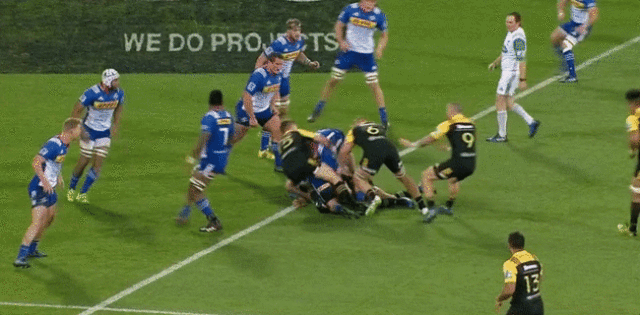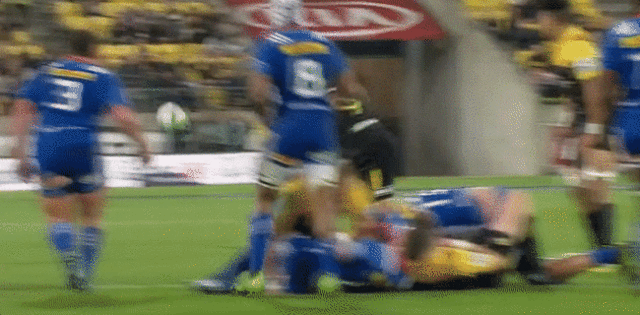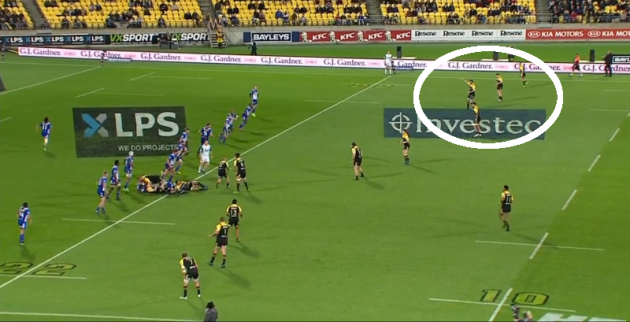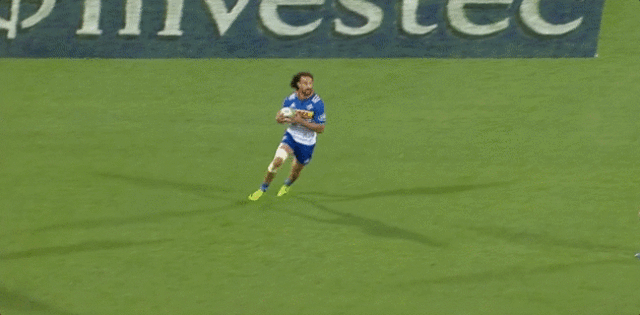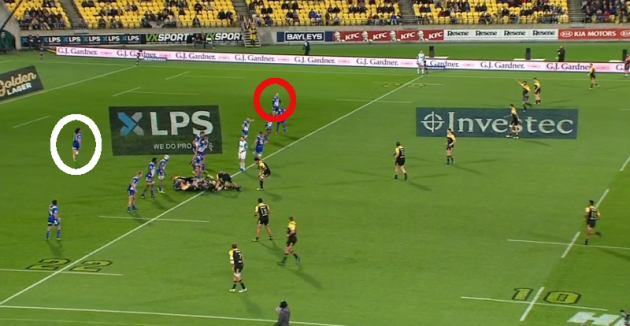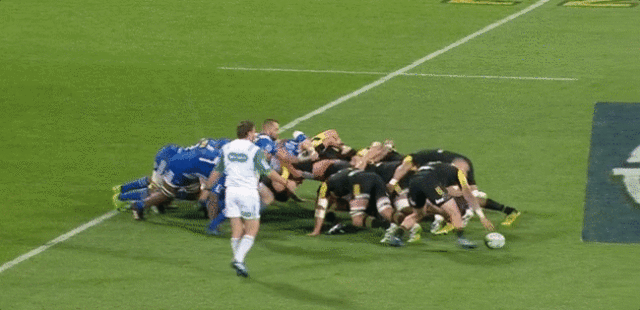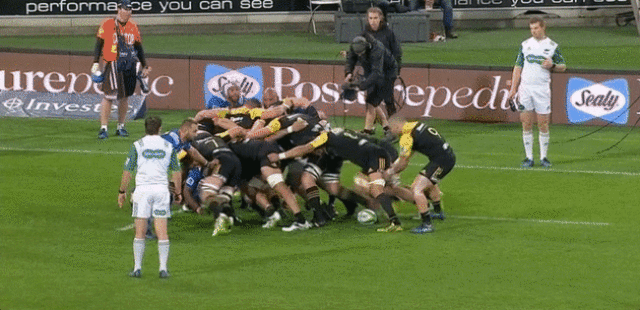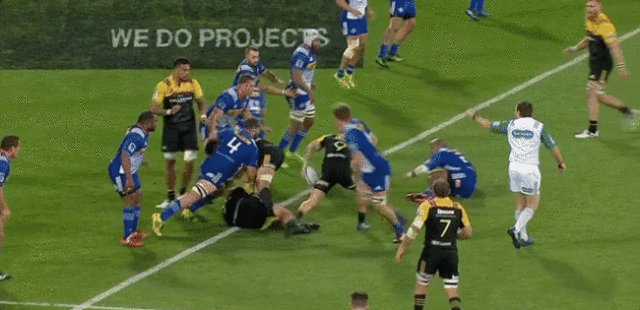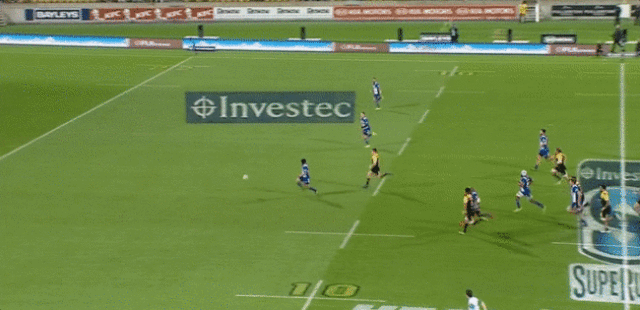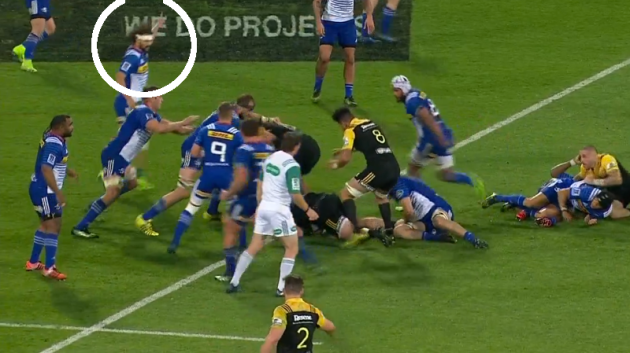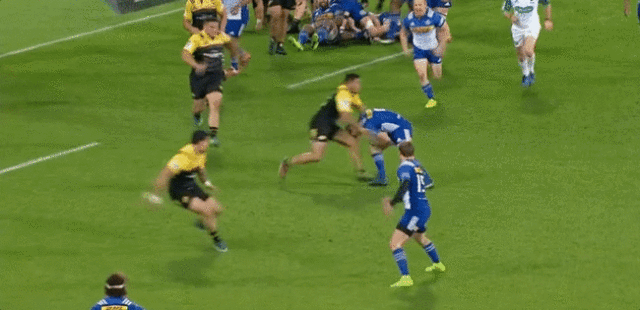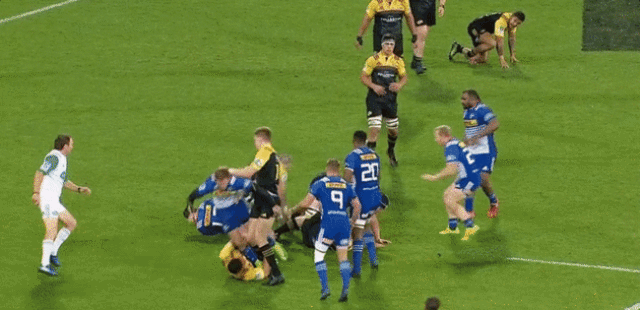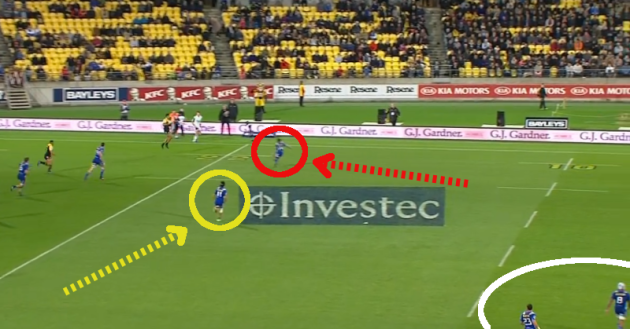THE KICK PASS is not new in rugby but it is now redefining the game by changing how teams attack.
Unsurprisingly, New Zealand sides are leading the way and the brilliance of Beauden Barrett is standing out.
The Hurricanes man will be wearing 10 for the Kiwis this summer against the Lions barring injury, and his excellence in this area will be a major threat to Warren Gatland’s side. The Lions will also have to worry about it in every single one of the warm-up games.
Barrett may be very the best, but he’s not the only player in the world who utilises the kick pass to great effect. We see examples in the Northern Hemisphere – take Ruan Pienaar’s beauty for Ulster against Leinster on Saturday – while New Zealand sides are now consistently using the kick pass effectively.
There was one such kick during the Highlanders’ stunning comeback win over the Cheetahs last weekend, when Tony Brown’s team scored three tries in the closing five minutes to turn around a 41-24 deficit and win 45-41.
This kick is a fine example of how confident the Kiwi sides are in their kick pass skills.
The clock reads 78.33 when Marty Banks kicks the ball and the Highlanders trail 41-38 at that point. An advantage in their favour has just ended, so it may seem like a risky decision from Banks to kick the ball.
However, when a skill has been practiced frequently enough that the players are totally confident in their ability to execute it, the risk is essentially removed.
In this instance, the kick pass makes total sense for the Highlanders.
As we can see above, there is clear space for Banks to kick into wide on the right and Waisake Naholo [circled] is up flat, ready to run onto the ball.
Banks has team-mates to his right who he could pass to, but the quickest way to get the ball into the space is through the boot and he dinks his kick across, probably getting a little bit too much height on it but finding Naholo.
It obviously helps to have an explosive wing on the end of the kick to beat two men and throw an offload, and the Highlanders surge up to the Cheetahs’ 22 here and eventually score the winning try through Naholo to cap one of the most memorable comebacks in Super Rugby history.
Now, we’ve all seen kicks like Banks’ one before, but the ingenuity of what is happening in New Zealand right now is when we’re seeing these kicks happen.
The kick pass has often been a weapon used at the end of multi-phase passages when the defence has tightened up, or from set-piece, when the attack has knowledge of exactly how the defence will set up.
But the Kiwi sides, led by the Highlanders and especially the Hurricanes are firing off these types of kicks on turnover possession.
Let’s rewind and look at the phase of play just before Banks kicks.
Banks has just chipped the ball out of the Highlanders’ 22 and the Cheetahs make a catastrophic error by knocking the ball on.
It’s a turnover situation for the Highlanders, having been gifted the ball back, but just watch Banks’ instant reaction to the knock-on. He is immediately looking to his right to check his options and he is instantly aware of Naholo up flat for the kick pass.
It’s a change of mentality from the traditional approach that tells us we should never kick turnover possession.
The ‘two-pass rule’, whereby the attack looks to instantly make two passes to shift the ball into space, has long been accepted as gospel. But what if a single kick can get the ball to that space more accurately and rapidly?
The Kiwi sides have figured it out and while the Highlanders are excellent proponents, particularly with Lima Sopoaga in their team, the Hurricanes are leading the way with Barrett’s kicking brilliance.
The 25-year-old was in sensational kick passing form last weekend as he tore the Stormers apart in a 41-22 victory for the Canes.
Above, we see the Canes’ first try through Cory Jane, who gets on the end of a sumptuous Barrett kick pass.
Firstly, let’s look at the sheer technical quality of the strike from the out-half. His consistency in this department is off the charts.
The trajectory of Barrett’s kick is deliberately low to ensure the defence can’t react while the ball is in the air and scramble across to tackle Jane, so the out-half drops the ball low to the ground for his kick.
Note the relative lack of drawback in his kicking leg too, as well as the lack of follow-through, as Barrett looks to ensure that he doesn’t get too much power into the kick.
It’s still a smooth motion into the kick, with Barrett calmly dropping the ball and keeping his eyes focused on the point of contact, but there is a slight flick in the lower half of his leg to stab the ball just over the final defender.
Again, the space here is clear for the Canes and we should note just how well set up they are for a kick pass, rather than shifting the ball through the hands.
There are four Hurricanes players hanging wide to the right and very flat to Barrett. Indeed, lock Mark Abbott, pointing to signal the space, is actually slightly ahead of Barrett in the shot above.
This image illustrates how tuned in the entire Canes team are to the possibility of kicking into the space to score, as well as how every player takes on a role of communicating the opportunity to Barrett.
Again, it’s important to note where the Canes’ possession comes from in this instance.
Again, it’s a turnover situation as Brad Shields blocks down Dillyn Leyds’ kick and taps the ball to Ngani Laumape, who bursts towards the 22.
The fact that it’s Lleyds who gets caught out is even more damaging to the Stormers, meaning they are now short a player in their backfield to cover the kick space.
As the Hurricanes recycle the ball as rapidly as possible, we can see that Lleyds [white] is doing his best to get across and cover the possible kick space for the Stormers.
But he’s been delayed by having to retreat down the pitch to get behind the ball, and the Canes have identified the space.
We can also see SP Marais [red] is very tight on the left edge of the Stormers’ defence and that’s another cue for the Canes to kick into the space outside him.
Should the Stormers defence be wider? Absolutely – TJ Perenar’s pass to Barrett instantly removes four defenders from the equation. But remember, this is a turnover situation and it’s very hard for the Stormers to get into ideal shape as they retreat.
The Canes could move the ball through the hands – the two-pass rule – to get to the space wide on the right, but the kick pass makes more sense and Barrett’s accuracy, dipping the ball just over the head of Marais is sensational to allow Jane to gather and finish.
As a brief aside and just to add another layer the Kiwis’ kicking threat, their second try came from a kick too.
This time it’s a TJ Perenara grubber kick and here lies more danger for the Lions this summer, with Kiwi sides excellent at this skill too.
We also see a brilliant bit of finishing from the prodigious Jordie Barrett to score the try after stripping Nizaam Carr.
But back to our kick pass focus.
The Canes’ third try comes after another contribution from Beauden’s boot.
This shows us how the Kiwi sides use the kick pass from set-piece platforms, the scrum in this case, with Julian Savea holding width on the left touchline and Barrett finding him after a dummy play in midfield.
If we’re being picky, it’s not Barrett’s best kick as it hangs in the air longer than he might have planned it to, but we must remember how exacting a skill this is.
Stormers fullback Marais needs to go to cover Savea earlier here and make a bigger impact with his tackle, but brilliant offloads from ‘The Bus’ and Jordie Barrett allow the Canes to finish.
10 minutes later, Beauden strikes again.
This time it’s younger brother Jordie who is on the end of the kick, another delicious strike of the ball.
This score is incredibly similar to the first through Jane. The possession source? Again, a turnover.
And again, it’s a turnover from an initial kick by the Canes – the same thing we saw with Banks’ kick pass and for the Cory Jane try.
These are brilliant illustrations of how the Kiwi sides pressure the opposition with their kicking game – forcing these turnovers – and then use their kicking game as a scoring weapon – with their kick passes, grubbers and chips.
Once again, the Stormers are in disarray here, having had to retreat from Perenara’s initial kick out of the Hurricanes’ half.
We can see left wing Lleyds [white] above, in behind the ruck rather than out wide ready cover space there.
As the Canes recycle the ball, the Stormers are scrambling hard.
Marais [red below] sprints across to the left side of their defence, but then opts to join the frontline rather than cover the space in the backfield.
The space is apparent – with the Stormers tight after retreating and being turned over – as Marais shoots up hard, looking to close down the passing options for Barrett.
But Barrett has little interest in passing here, and his team-mates are in position for a kick anyway, the whole team accepting this mindset of kicking to score on turnover possession.
Watch Lleyds [11] in the clip below, realising with desperation that Barrett is going to kick again.
Lleyds points to the Stormers’ backfield, signalling for Marais to drop back and field the kick, but the fullback has already made his decision amidst the intense pressure the Stormers find themselves under after losing possession just outside their 22.
Again, note how flat Barrett’s team-mates are and how hard they have worked to get their width within seconds of the turnover taking place.
They test the offside line in their eagerness to get after the ball, but Jordie Barrett gets his reward for a lung-busting run all the way up from the backfield, having instantly switched into this collective kick pass mindset after the turnover.
Beauden’s skill execution is once again supreme, showing the evidence of countless of hours practicing his kicking.
It’s worth noting that Barrett kicks from the centre of the pitch too, another element of how this style of kicking is changing. We’re more used to seeing longer, hanging ‘cross-field’ kicks from closer to the edges of the pitch, but this is slightly different.
It’s lower, it’s shorter and it’s even harder to defend, particularly now that it’s happening so frequently on turnover situations, when the defence simply cannot get into ideal shape.
To their credit, the Stormers fought back into this game – having great success at the maul – and trailed only 27-22 in the 73rd minute, when they were attacking in the Hurricanes’ 22 and applying major pressure with the Kiwi side down to 14 men due to a yellow card.
But the South Africans lost possession and once again Barrett punished them with a superb kick pass.
It’s a loose offload that does the damage on this occasion, but we instantly see the positive intent from the Canes on turnover ball as Perenara offloads out of the tackle.
Ben Lam makes a carry to the right, before Barrett pounces.
It’s a ballsy play from Barrett and the Canes at such a pivotal moment in the game, but it is the right decision without a doubt.
The Stormers are expecting the Hurricanes to simply boot the ball deep to clear their lines, having been under intense pressure and given that they are down to 14 men. That’s exactly what the majority of teams would do, looking to find the ‘safety’ of the touchline.
The Stormers are hopeful that Barrett or Perenara might miss touch and they set up to run the ball back at the Canes in that event.
That’s why we see Carr and replacement Bjorn Basson [white] so deep in the image above.
Cheslin Kolbe [red] has also started deep and is then forced to come forward when Barrett kicks to Savea wide on the left.
We can also see poor old Lleyds trying to get across from close to the ruck, hoping to make a tackle on the edge as the Canes torment the Stormers with their kick passing game.
Again, the Stormers are narrow in their frontline, with lock JD Schickerling not in the ideal place to react to the kick and cover across.
The space is blatantly obvious when we’re able to pause play and get a nice angle on it as here, but Savea and Barrett have spotted it quicker than anyone.
There is open space for Barrett to kick into and he has the skills to make the kick pass here. So is it actually ballsy?
To a degree, yes, but when we consider that the space is there and that Barrett has practiced this kick enough to be accurate the majority of the time, it’s simply the right decision.
When we caught up with Hurricanes attack coach Jason Holland, a former Munster player, after their Super Rugby triumph last year, he explained the keys to their success.
“If [the opposition] showed edge space, we ran. If the wingers came up and they showed kick space, we kicked. The skills will happen, but if you can get the boys making good decisions based on what they see – it’s the crux of the game.
“There’s obvious things you need to be nailing – your set-piece and physicality – but I believe that if you can nail your decision-making and you know there’s got to be space somewhere and we go to that space, then your skills will work.”
The42 is on Instagram! Tap the button below on your phone to follow us!

